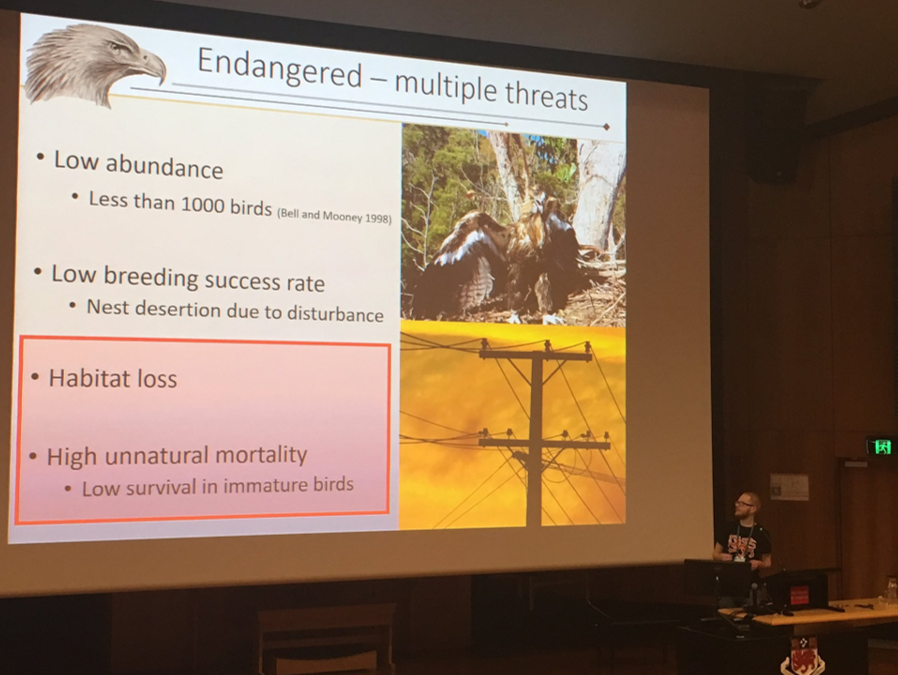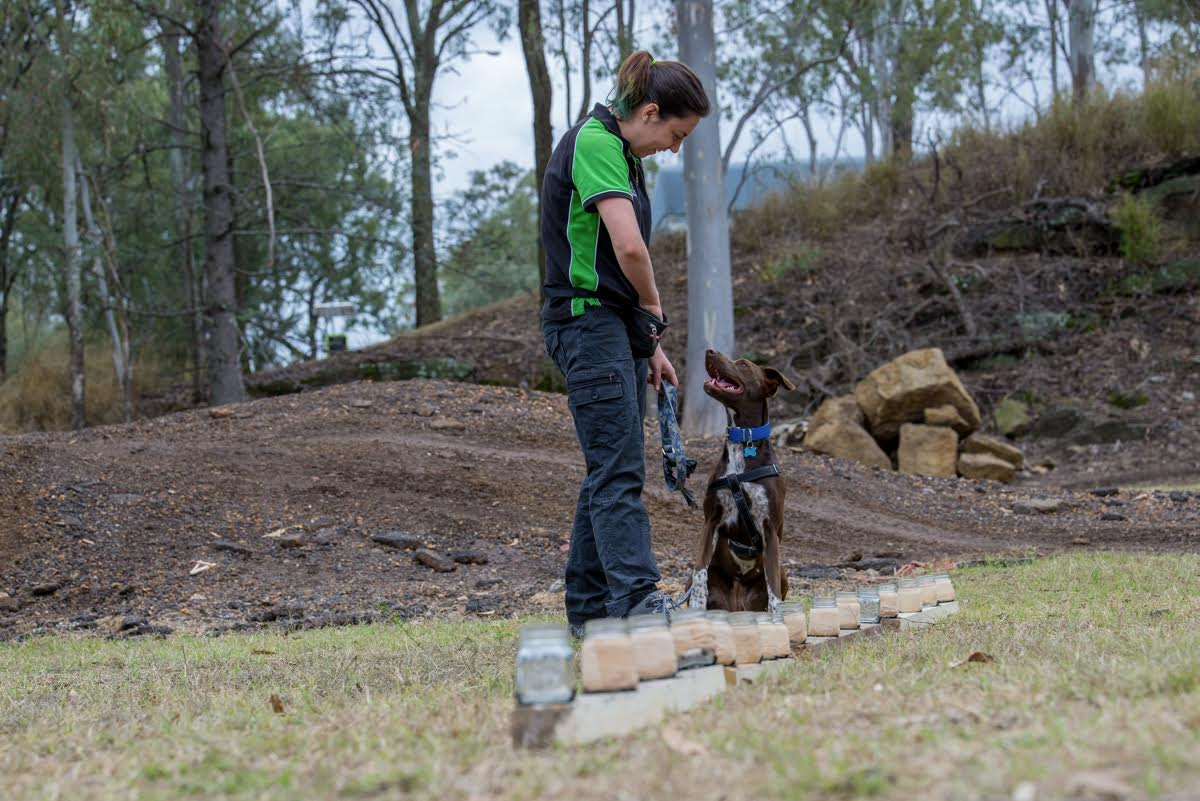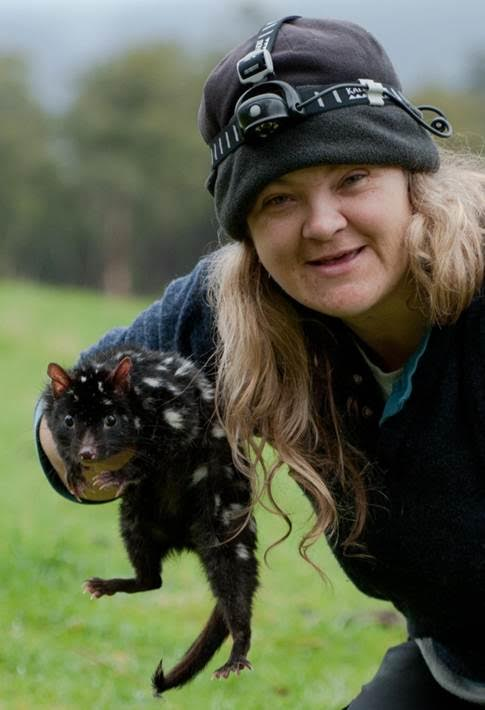| |

From the President
From the President I don’t know about the rest of you, but it feels like only yesterday that I was reading the March AWMS Newsletter. Somehow four months have gone by. This time of year seems to be the busiest for me – field work, EOFY funding reports, milestone reports and yet more field work. I imagine it’s how academics feel in November with all of that marking. All of the analysis of the data is still to come of course, so it doesn’t seem like things are going to let up anytime soon.
There are some exciting things happening around the place at the moment. Your committee continues to have interesting discussions around additional benefits for members. Remember, if you have a suggestion, we are always happy to hear it. This year we have subsidised the cost of the conference for all of our members. Just one of the many ways we are trying to give back to you in thanks for your support.
Registration for the conference is now open. Field trips are still being finalised so keep your eye on the website for when those details are released and the trips are opened for bookings. The focus for this year’s conference is Wildlife Management in Remote Landscapes. Many of us work in these challenging landscapes, and having previously worked in a remote part of the NT, I’m looking forward to hearing about the variety of work and wildlife management practices being undertaken in these parts of our country. The last time we went to Darwin was 1999 so this is a great opportunity to experience the northern part of our country. We hope you can make every effort to attend this year.
Finally, I’d like to welcome Margarita Medina to the role of newsletter editor. Margarita is our social media manager (and doing a great job), so I think her offer to take over the newsletter is a perfect fit!
Until next time. Tarnya.
 Best Student Presentation 2018 Best Student Presentation 2018
Pre-dispersal Behaviour and habitat associations of the Tasmanian wedge-tailed eagle (Aquila audax fleayi)
James Pay
School of Natural Sciences, UTAS, Hobart, Tas
James.Pay@utas.edu.au
Abstract
Apex predators play a major role in maintaining the trophic dynamics of ecosystems, and as such are of vital concern to biodiversity conservation. Since the loss of the thylacine ( Thylacinus cynocephalus) and the decline of the Tasmanian devil ( Sarcophilus harrisii), the Tasmanian wedge-tailed eagle ( Aquila audax fleayi) is now Tasmania's primary top predator. However, the population is listed as endangered at both a state and federal level, with conservation concern based partly upon a high mortality rate in sub-adult birds. Despite this concern there is very little known about the behavioural ecology of juvenile wedge-tailed eagles. The behaviour and habitat associations of 25 juvenile Tasmanian wedge-tailed eagles were investigated using GPS telemetry. The telemetry units recorded the location, altitude and speed the birds were travelling every 15 minutes. This provided highly detailed information on the spatial ecology of the species, as well as insight into the causes and rates of mortality. Mortality rates were lower than expected, with only two eagles dying within the first year. Juvenile eagles remained in their natal territory much longer than expected and revisited their natal nest trees long after fledging. Biased random bridge kernels were used to assess natal home-ranges, and the habitat associations of the eagles were investigated using compositional analyses. Results from the study will help guide the conservation management of the population.
Best Student Presentation 2018 (runner up)
Balancing tourism and conservation - Testing the effectiveness of a minimum approach guideline for yellow-eyed penguins in the subantarctic
Rebecca French
Wildlife and Ecology group, Massey University, Palmerston North 4442, New Zealand
rebecca.french@outlook.co.nz
Abstract
To balance tourism and conservation effectively, the impact of human disturbance on wildlife must be minimised. Enderby Island (part of the Auckland Island archipelago, in the New Zealand subantarctic) is thought to have the highest density of Yellow-eyed Penguins (Megadyptes antipodes, hoiho) in the world, and is also the only place in the subantarctic where tourists regularly come into contact with Yellow-eyed Penguins. Restrictions and guidelines for tourism are in place on Enderby Island, but there has been little study on the efficacy of these. We quantified behavioural responses of the Yellow-eyed Penguin on Enderby Island to human presence by documenting movement patterns and behaviour of penguins in the presence and absence of humans, through both controlled approaches and monitoring penguin behaviour in the presence of tourists. We used these data to model the effective approach distances for reducing disturbance and compare this to the current minimum approach guideline. In this talk, we discuss the behavioural impact of human presence, and present ideas on how regulation of tourism could be improved to reduce anthropogenic impact on vulnerable species such as the Yellow-eyed Penguin.
 Best student poster 2018 Best student poster 2018
Don’t believe those puppy eyes – improving wildlife detection dog accuracy

La-Toya Jamieson
The University of Queensland, Warrego Highway, Gatton, Queensland, Australia
la.jamieson@uq.net.au
About La-Toya Jamieson
I have recently survived submitting my PhD thesis for examination. My PhD research aimed to improve our understanding of factors which affect wildlife detection dog and handler selection, along with the impact changing handlers has on their working dogs' behaviours and detection performance. I've also recently begun working for Zoos Victoria as a Wildlife Detection Dog Officer where I hope to continue my research.
Abstract
Wildlife detection dogs are trained to locate wildlife species or their biological traces. This method can determine species presence and distribution efficiently, without the target species being viewed or handled. As the data generated by detection dogs are often used to create environmental management plans, it is crucial these dogs complete minimal false positives and negatives. This research aimed to determine if dogs’ smelling times and their associated behaviours could be used as predictors of true and false positives and negatives. Video footage of 10 dogs trained to locate Bengal Tiger (Panthera tigris tigris) scat were behaviour coded at 0.1 speed and the dogs’ smelling times recorded. For all dogs there was a significant difference in the length of smelling time for true negatives (0.273 ± 0.04), in comparison to true positives (0.505 ± 0.14, p = 0.003) and false positives (0.456 ± 0.12, p = 0.008). The dogs’ indication times were also shorter for true positives (0.398 ± 0.03) than false positives (0.451 ± 0.07). Behaviours completed prior to these indications were dependent on the individual dog. ‘Look to handler’ and ‘paw-lift’ were behaviours associated with true positives, while ‘distracted’ and ‘side gaze’ were behaviours associated with false negatives. These results demonstrate that smelling times can be used to predict whether dog indications are true or false. These results also demonstrate the benefit of dog handlers reviewing their training footage to determine their dog’s subtle working behaviours. This would be especially beneficial for new or inexperienced handlers.
The devil inside: Preliminary dietary analysis reveals broad depth of prey items in an island population of Tasmanian devils (Sarcophilus harrisii)
Elspeth McLennan
School of Life and Environmental Sciences, University of Sydney, NSW, 2006, Australia
elspeth.mclennan@sydney.edu.au
Abstract
In response to the emergence of devil facial tumour disease (DFTD) and the resultant population declines, a captive insurance population of Tasmanian devils was established in 2006 with a free-ranging subpopulation later established on Maria Island, Tasmania. We aimed to quantify the impact of introducing a top-order predator to a naive ecosystem and more broadly provide evidence for the efficacy of assisted colonisations. Using a metabarcoding approach, DNA was amplified from six-pilot samples targeting a ~100bp region of the 12S mitochondrial genes, with and without a predator-specific blocking oligonucleotide, and sequences on a Miseq platform. Sequences were filtered, cleaned and assigned to taxa using the OBITools program. We identified a total of 14 prey items, six marsupials, one monotreme, two fish, one marine mammal, three birds and one reptile, none of which are vulnerable species of concern. The blocking oligonucleotides reduced the amplification of Tasmanian devil DNA by 50% without affecting amplification of closely related species. These results confirm that as scavengers, devils have a diverse diet, feeding primarily on other marsupials and validates the methodology used. Understanding the impact of an introduced predator is essential to determining success of an assisted colonisation as a conservation tool. The validated methods of the present study will enable both a more in-depth analysis of devil predation on Maria Island and help to inform future studies of a similar nature.

DW Cooper award winner
Disturbance Ecology of the greater bilby (Macrotis lagotis)

Stuart Dawson
Environmental and Conservation Sciences, School of Veterinary and Life Sciences, Murdoch University, Murdoch, Western Australia S.Dawson@murdoch.edu.au
About Stuart Since finishing my schooling in Perth (and promptly moving to Darwin to chase crocodiles), I have spent much of my professional and academic life in northern Australia. I commenced my PhD research in 2014, and spent much of the following three years travelling between the West Kimberley and home, in Perth. The majority of my research has focused towards the management of threatened species, and the impacts of introduced predators, and I have endeavoured to follow the communication of this science through to land managers, such as the resources and agricultural sectors, and conservation and indigenous ranger organisations. Since finishing my PhD, I have been working as a biological consultant, again, spending much of my time in northern Australia (it appears to be recurring trend…)
Abstract
Understanding how species respond to disturbance, both natural and anthropogenic, can be crucial to designing effective and targeted management strategies. I investigated the habitat selection, predator-prey interactions, and ecosystem engineering of the greater bilby in the grazed rangelands of the West Kimberley. I also explored the impacts of fire and clearing of seismic lines (for petroleum exploration) on these processes. Firstly, I used remotely sensed and field sourced habitat characteristics to identify and predict the presence of bilbies. All variables used had little power to explain the presence of bilbies. Secondly, I investigated the effect of disturbance at two scales; at a fine scale, by investigating the use of seismic lines by a range of species, and at a broad scale, by recording changes in the occupancy of a range of species within a disturbed area. Seismic lines were used by bilbies, cats, and dingoes, increasing the spatial and temporal overlap between bilbies and potential predators. Thirdly, I tested the efficacy of contemporary methodologies for identifying bilby diet, determining that DNA barcoding can improve identification of dietary items from scats. Anthropogenic disturbance can influence predator-prey interactions, which may increase the predation pressure on an already vulnerable species, adding to existing management concerns for bilbies in the West Kimberley associated with vegetation clearing, unmanaged and frequent broad-scale fires, and cattle grazing. Land managers should work in concert to reduce pressures on bilbies, by using coordinated and targeted cat control, and managing fires to increase fire-age heterogeneity.
 President's Award Winner President's Award Winner
Evaluation of different strategies for the landscape control of feral cats
Bronwyn Fancourt
Research Fellow, School of Environmental and Rural Science, University of New England
Bronwyn.Fancourt@daf.qld.gov.au
About Bronwyn
I am a wildlife ecologist with interests in applied management outcomes. I completed my Honours and PhD research in Tasmania, investigating the cause of decline of the eastern quoll. I have subsequently worked on developing and refining monitoring techniques to detect and eradicate rabbits, and since 2016 I have worked with various state government agencies on improving feral cat management in eastern Australia.
Abstract
Abstract Feral cats are notoriously difficult to control effectively at the landscape scale. We investigated the efficacy of two potential approaches to the broadscale control of feral cats: the use of larger predators (Tasmanian devils in Tasmania and dingoes in Queensland); and feral cat baits (the “Queensland Curiosity 1080’ fresh meat bait, and the chipolata-style ‘Eradicat’ bait). Devil and cat detections on individual cameras were negatively correlated, however this was unrelated to abundance. Some temporal separation of cat and devil activity was evident, and while cats appeared to avoid devils over short distances, both species were consistently detected at the same sites, indicating devils were not excluding cats. Dingoes and cats exhibited marked spatial and temporal overlap, indicating coexistence between these predators. Dingoes did not exclude cats from any areas, with cat activity higher at times and in places where dingoes were active. There was evidence of within-night spatiotemporal separation between dingoes and cats. However, cats remained active, abundant and widespread across the site, with evidence of cats hunting and breeding successfully in areas occupied by dingoes. Fresh meat baits were ineffective, with only 11% of collared cats killed and no observed reduction in feral cat abundance across the site. Eradicat baits were more effective, with a significant 40% of collared cats killed, and a similar significant reduction in feral cat abundance across the site. Juvenile survival of a key threatened species improved following the Eradicat baiting program, suggesting that this bait may provide positive outcomes for species threatened by feral cats.
Conference call for abstracts 2019
Abstracts are now being accepted for this years AWMS conference in Darwin 3-5 December. The call for abstracts closes August 31 so download the Call for Abstracts now! Or find the abstract submission form here.
.jpg)

awms awards 2019
AWMS Awards are now open for application! AWMS has a wide range of awards available for its members.
Practitioner Award - to recognise those practitioners implementing outstanding wildlife management in their field
D.W.Cooper Student Thesis Award - for a thesis of excellence within the field of scientifically-based wildlife management research
Postgraduate Research Award - to facilitate postgraduate student (Masters and PhD) research associated with the scientific management of wildlife
Honours and Undergraduate Travel Award - to facilitate tertiary (undergraduate and Honours) student involvement in the range of fields associated with the scientific management of wildlife
Braysher Management Fund - to support studies and other initiatives that address practical (rather than theoretical) wildlife management problems where community involvement is fundamental to the success of the programme.
Best Student Presentation and Poster - At the annual AWMS conference all students can be judged in the 'Best Student Presentation'. Entry is not compulsory.
All applications close 31 August 2019. Head to our website for more information
 Invitation For Students to Present at the Australasian Wildlife Management Society Conference 2019 Invitation For Students to Present at the Australasian Wildlife Management Society Conference 2019
Put your students to the ultimate test by sending them to the top end of Australia! The gorgeous tropical paradise of Darwin is much more than it’s croc’ed up to be; as this year it’s home to the AWMS annual conference. This year’s theme ‘Wildlife Management in Remote Landscapes’ is a ‘top’ opportunity for students to present their research and meet up to 200 delegates from all over Australasia. We are calling for student abstracts NOW (submission deadline 31st August 2019). Now’s the perfect time to join AWMS and come to our annual conference, with reduced conference registration and generous student travel subsidies. For early bird prices, register before 30th September.
Looking forward to seeing you all there!
committee POSITIONS available
This year a number of Committee positions will open for nomination. While an official call for nominations will come out in the next newsletter and via email, the AWMS Committee encourages members to consider supporting their Society by nominating for a position. Anyone considering a position on the Committee will require a member to nominate them and an additional member to second that nomination. Full details will be provided closer to the conference. All positions are two year terms and current holders of the positions can re-nominate. Positions up for nomination are:
- Vice President
- Treasurer
- Membership Secretary
- Committee Member 1
- Committee Member 2
- Committee Member 3
- Australian Student Representative
- New Zealand Student Representative

member publications
Due to the overwhelming response from our members, we can only listed publication titles and contact details for corresponding authors. It's good to see so many papers being produced by AWMS members.
Roan Plotz Chambers, L., Lui, S., Plotz, R., Hiriasia, D., Malsale, P., Pulehetoa-Mitiepo, R., Natapei, M., Sanau, N., Waiwai, M., Tahani, L. and Willy, A. (2019). Traditional or contemporary weather and climate forecasts: reaching Pacific communities. Regional Environmental Change, pp.1-8. https://link.springer.com/article/10.1007/s10113-019-01487-7
Malsale, P., Sanau, N., Tofaeono, T.I., Kavisi, Z., Willy, A., Mitiepo, R., Lui, S., Chambers, L.E. and Plotz, R.D. (2018). Protocols and partnerships for engaging Pacific Island communities in the collection and use of traditional climate knowledge. Bulletin of the American Meteorological Society, 99(12), pp.2471-2489. https://journals.ametsoc.org/doi/full/10.1175/BAMS-D-17-0163.1
Hayward, M.W., Ripple, W.J., Kerley, G.I., Landman, M., Plotz, R.D. and Garnett, S.T. (2018). Neocolonial conservation: is moving rhinos to Australia conservation or intellectual property loss. Conservation Letters,11(1), p.e12354. https://onlinelibrary.wiley.com/doi/full/10.1111/conl.12354
Bannister H, Brandle R, and Moseby K. (2018). ‘Antipredator behaviour of a native marsupial is relaxed when mammalian predators are excluded’. Wildlife Research 45:726-736. https://www.publish.csiro.au/WR/WR18060
Bannister HL, Hodgens P, and Moseby KE. (2019). ‘Offspring sex and maternal effects influence the development and natal dispersal of an arboreal marsupial’. Journal of Mammalogy, 100:423-434. https://academic.oup.com/jmammal/article-abstract/100/2/423/5364434?redirectedFrom=fulltext
Glen, A. S., Russell, J. C., Veltman, C. J., and Fewster, R. M. (2018). I smell a rat! Estimating effective sweep width for searches using wildlife-detector dogs.
Wildlife Research 45, 500-504. http://www.publish.csiro.au/wr/WR18021
Nottingham, C. M., Glen, A. S., and Stanley, M. C. (2019).Proactive development of invasive species damage functions prior to species reintroduction. Global Ecology and Conservation 17, e00534. https://www.sciencedirect.com/science/article/pii/S2351989418305018?via%3Dihub
Glen, AS, Perry, M, Yockney, I, Cave, S, Gormley, AM, Leckie, C, Dickson, R, Rakete-Stones, W, Rakete-Stones, P, Norbury, GL and Ruscoe, WA. (2019). Predator control on farmland for biodiversity conservation: a case study from Hawke’s Bay, New Zealand. New Zealand Journal of Ecology 43, 3358. https://newzealandecology.org/nzje/3358.pdf
Northover, A.S., Keatley, S., Godfrey, S.S., Lymbery, A.J., Wayne, A.F., Cooper, C., Pallant, L., Morris, K. and Thompson, R.C.A. (2019). Increased Trypanosoma spp. richness and prevalence of haemoparasite co-infection following translocation. Parasites & Vectors 12: 126. https://parasitesandvectors.biomedcentral.com/articles/10.1186/s13071-019-3370-6
Gorissen S, Greenlees M and Shine R. (2018). The impact of wildfire on an endangered reptile (Eulamprus leuraensis) in Australian montane swamps. International Journal of Wildland Fire, 27(7): 447–456. https://doi.org/10.1071/WF17048
Fabian, M. C., Cook, A. S.; and Old, J. M. (2019a). Attitudes towards wildlife conservation. Australian Zoologist, In Press.
Fabian, M. C., Cook, A. S.; and Old, J. M. (2019b). Do Australians have the willingness to participate in wildlife conservation? Australian Zoologist, In Press.
Green-Barber, J. M.; Old, J. M. (2018a). The genetic relatedness of a peri-urban population of eastern grey kangaroos. BMC Research Notes, 11, 856. https://www.ncbi.nlm.nih.gov/pubmed/30514393
Green-Barber, J. M. and Old, J. M. (2018b). Is camera trap videography suitable for assessing activity patterns in eastern grey kangaroos? Pacific Conservation Biology, 24, 134-141. http://www.publish.csiro.au/pc/PC17051
Green-Barber, J. M. and Old, J. M. (2018c). Town roo, country roo: a comparison of behaviour in eastern grey kangaroos Macropus giganteus in developed and natural landscapes. Australian Zoologist, 39, 520-533. https://publications.rzsnsw.org.au/doi/10.7882/AZ.2018.019
Green-Barber, J. M., Ong, O. T. W., Kanuri, A., Stannard, H. J. and Old, J. M. (2018a). Blood constituents of free-ranging eastern grey kangaroos (Macropus giganteus). Australian Mammalogy, 40. https://www.publish.csiro.au/AM/AM17002
Green-Barber, J. M., Stannard, H. J. and Old, J. M. (2018b). A suspected case of myopathy in a free-ranging eastern grey kangaroo (Macropus giganteus). Australian Mammalogy, 40, 134-141. http://www.publish.csiro.au/AM/AM16054
Old, J. M., Hunter, N. E. amd Wolfenden, J. (2018a). Who utilises bare-nosed wombat burrows? Australian Zoologist, 39, 409-413. http://publications.rzsnsw.org.au/doi/10.7882/AZ.2018.006?code=RZSW-site10.7882/az.2018.006
Old, J. M., Sengupta, C., Narayan, E. and Wolfenden, J. (2018b). Sarcoptic mange in wombats-A review and future research directions. Transboundary and Emerging Diseases, 65, 399-407. https://onlinelibrary.wiley.com/doi/abs/10.1111/tbed.12770
Skelton, C., Cook, A., West, P., Spencer, R.J. and Old, J. M. (2018). Building an army of wombat warriors: developing and sustaining a citizen science project. Australian Mammalogy. https://www.publish.csiro.au/AM/AM18018
Pulsford, S.A., Barton, P.S., Driscoll, D.A. and Lindenmayer, D.B. (2019). Interactive effects of land use, grazing and environment on frogs in an agricultural landscape. Agriculture, Ecosystems & Environment, 281, pp.25-34. https://www.sciencedirect.com/science/article/pii/S016788091930132X
Margres, M.J., Jones, M.E., Epstein, B., Kerlin, D.H., Comte, S., Fox, S., Fraik, A.K., Hendricks, S.A., Huxtable, S., Lachish, S. and Lazenby, B. (2018). Large‐effect loci affect survival in Tasmanian devils (Sarcophilus harrisii) infected with a transmissible cancer. Molecular ecology, 27(21), pp.4189-4199.
https://onlinelibrary.wiley.com/doi/abs/10.1111/mec.14853
Hivert, L.G., Clarke, J.R., Peck, S.J., Lawrence, C., Brown, W.E., Huxtable, S.J., Schaap, D., Pemberton, D. and Grueber, C.E. (2018). High blood lead concentrations in captive Tasmanian devils (Sarcophilus harrisii): a threat to the conservation of the species?. Australian veterinary journal, 96(11), pp.442-449. https://onlinelibrary.wiley.com/doi/abs/10.1111/avj.12753
Dawson, S. J., Broussard, L. , Adams, P. J., Moseby, K. E., Waddington, K. I., Kobryn, H. T., Bateman, P. W. and Fleming, P. A. (2019). An outback oasis: the ecological importance of bilby burrows. J Zool. https://zslpublications.onlinelibrary.wiley.com/doi/abs/10.1111/jzo.12663
Edwards, MC, Hoy, JM, FitzGibbon, S and Murray, PJ. (2018). ‘Training a wild-born marsupial to use microchip-automated devices: the brush-tailed phascogale (Phascogale tapoatafa) as proof of concept’, Australian Mammalogy, 10.1071/AM18017 http://www.publish.csiro.au/AM/AM18017
Fancourt, B.A., Hawkins, C.E. and Nicol, S.C. (2018). Mechanisms of climate change-induced species decline: spatial, temporal and long-term variation in the diet of an endangered marsupial carnivore, the eastern quoll. Wildlife Research, 45, 737-750.
http://www.publish.csiro.au/WR/WR18063
Fancourt, B.A. and Nicol, S.C. (2019). Hematologic and serum biochemical reference intervals for wild eastern quolls (Dasyurus viverrinus): variation by age, sex and season. Veterinary Clinical Pathology, 48, 114-124. https://onlinelibrary.wiley.com/doi/abs/10.1111/vcp.12703
Hayward, M.W., Edwards, S., Fancourt, B.A., Linnell, J.D.C. and Nilsen, E.B. (2019). Top-down control of ecosystems and the case for rewilding: does it all add up? Rewilding (eds J.T. du Toit, N. Pettorelli and S.M. Durant), pp. 325-354. Cambridge University Press, Cambridge. https://www.cambridge.org/core/books/rewilding/topdown-control-of-ecosystems-and-the-case-for-rewilding-does-it-all-add-up/4FBF26BCF91229BE0374590D459A101C
Medina‐Romero, M., O'Reilly‐Nugent, A., Davidson, A., Bray, J., Wandrag, E., Gruber, B., Lopez‐Aldana, A., Palit, R., Reid, T., Adamack, A., Pietsch, R., Allen, C., Mac Nally, R. and Duncan, R.P. (2019). Effect of detection heterogeneity in occupancy‐detection models: an experimental test of time‐to‐first‐detection methods. Ecography. https://onlinelibrary.wiley.com/doi/abs/10.1111/ecog.04321
|